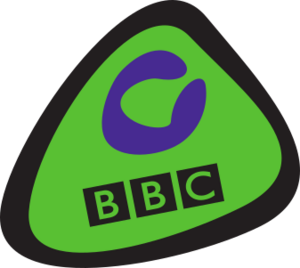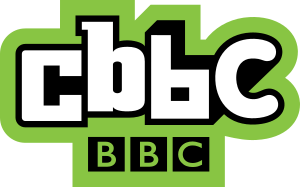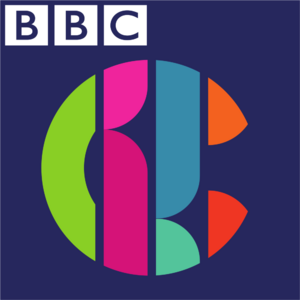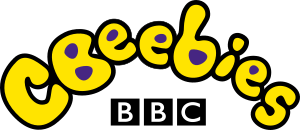CBBC idents facts for kids
Throughout the years, the Children's BBC, which later became CBBC and CBeebies, has used many different looks and logos. Each era had its own special style, making the channels easy to recognise.
Contents
How Children's BBC Started
Before Children's BBC officially launched on 9 September 1985, BBC1 had some special ways to show its kids' programmes. The idea for CBBC actually came from the "Children's Hour" on the very first BBC Television Service.
In the 1970s, the screen that showed what programme was next changed. It was blue and yellow and featured cartoon faces of a boy and girl. It also showed characters like Zebedee from The Magic Roundabout and Scooby-Doo, plus logos from Play School and Blue Peter. Later, in 1981, this slide changed to show a group of excited children looking at the screen.
Just before Children's BBC began, the BBC started using computer-made animations to introduce shows. For example, a spider might spin down to spell out "Hello from BBC1". Even with these cool new graphics, programmes were still introduced by the main BBC1 globe symbol, sometimes with a short, synthesised tune.
The Children's BBC Era
First Logos and the Broom Cupboard
The very first logo for Children's BBC was made using a computer. It showed the word 'Children's' above a big 'BBC' made of red, green, and blue letters. Each letter of 'BBC' would animate onto the screen with a short electronic sound. At first, it had a blue background, but this changed to black after a few months.
From the start, presenters would appear live on screen from a small studio, often called the "Broom Cupboard". This was a tiny space where presenters like Phillip Schofield would talk to viewers, show children's drawings and letters, and even help control the sound and vision for their links. It was a very personal way to connect with the audience.
In 1987, a new logo was introduced, made with stop-motion animation. This one showed images that started with each letter of "Children's" (like a car for 'C', a horse for 'H'). These images were drawn on screen by yellow lines, which then formed the 'BBC' logo.
By 1989, the "Broom Cupboard" got an upgrade with better sound. The presenters temporarily moved to an even smaller studio, which they jokingly called the "Boiler Room." Later that year, a new, shiny gold BBC logo with pale green "Children's" text was introduced, created live on air by a computer.
Corporate Look and New Idents
In 1991, the BBC updated its main channel logos, and Children's BBC got a new look too. This new logo put more focus on the 'Children's' part of the name. It featured large, bright neon-style letters for "Children's" against a dark, colourful background, with an upbeat soundtrack. The "Broom Cupboard" also got a makeover to match this neon style.
By 1994, Children's BBC moved out of the "Broom Cupboard" studio into a larger one. To mark this, they launched a new version of the logo, now in 3D and set against a moving rainbow background.
During this time, many different animated logos were created by BBC Manchester. These often featured cartoons or computer animations that included the Children's BBC logo. Some examples included:
- Alien - An alien spaceship hovers over a field where 'Children's' is written.
- Bee - A bumble bee turns into the black and yellow BBC logo.
- Pingu - A 2D Pingu builds a snow park, and the Children's logo appears.
- Sculptor - A man sculpts stone, revealing 'Children's', then turns into a child.
- Space - A spaceship crashes into a moon, leaving the Children's BBC logo.
These creative animations helped make Children's BBC feel fun and exciting.
The CBBC Channel Era
Yellow Animations (1997-2002)
On 4 October 1997, the BBC launched a new main logo, and all its channels, including CBBC, got a fresh new look. The new CBBC logo featured a 'C' added in front of the BBC blocks logo. This made it clear that CBBC was a part of the main BBC family.
The new idents (the short clips shown between programmes) were all yellow and black. They featured two-dimensional animations with surreal or adventurous scenes. For example:
- Cat and Bird - A bird finds a worm, which turns out to be a cat's tail!
- Dragon - A dragon tries to fly but falls down.
- Fish - A group of fish swim across the screen.
- Magician - A magician tries to pull something from his hat but gets embarrassed.
- Mouse - A mouse turns himself into a bicycle to ride away.
- Octopus - An octopus hides in its own ink.
The studio where presenters appeared also followed the yellow and black theme, with large CBBC logos and a big video wall.
The CBBC Bugs (2002-2007)
A big change happened on 11 February 2002. This day saw the launch of the dedicated CBBC Channel! At the same time, the CBeebies channel also launched. This meant CBBC now focused on children aged 8-12, while CBeebies was for younger kids.
To mark this, a new identity was created: the "bug" idents. These featured green, moving bug-like shapes that contained the BBC logo and a purple 'C'. The bugs could split apart or fight playfully. In 2003, the bugs even got their own "home" in the idents, with a lava lamp background and a purple building for the CBBC Channel. Presenters still appeared on screen, often with these bug animations playing in the background.
In 2005, the bug idea was updated to a "green gumdrop" era. Now, a single, larger, 3D bug would zoom around the screen. These idents also featured stars from CBBC shows, like Dani Harmer from Tracy Beaker or Basil Brush.
Stylised CBBC (2007-2016)
CBBC relaunched again on 3 September 2007 with a new logo where each letter of "CBBC" was in a different, unique style. New idents showed scenes where these four stylised letters would appear before coming together at the end. These scenes featured cartoon characters (like Shaun the Sheep) or stars from CBBC shows (like Barney Harwood or Basil Brush). Kids could even make their own "Mash Up" idents on the CBBC website, and some of these were shown on TV!
In 2010, the CBBC logo got a glossy 3D look, and the end screens of the idents changed to show this new logo moving around on green bars.
Modern Updates (2014-Present)
On 13 September 2014, CBBC introduced new idents, but kept the same logo. These new idents continued to feature animated scenes with references to popular programmes.
Then, on 14 March 2016, CBBC rebranded again with a new logo, similar to BBC Three's. New idents were introduced, showing everyday situations in a modern style. Examples include:
- Bed - A boy reading a book in bed, used for serious programmes.
- Drone - Drones flying different parts of the logo, used for after-school shows.
- Lights - Children using glow sticks to form the logo, for entertainment.
- Slinky - Kids placing slinkies on treadmills to make a loop, for factual shows.
- Window - A boy and girl throwing toy animals onto a window to form the logo, often for comedy.
CBeebies
CBeebies launched alongside the CBBC Channel on 11 February 2002. It was originally for pre-school children, but later included ages up to 6.
The idents for CBeebies feature yellow, bouncing blob-like characters, also known as the "Bugbies." These are the opposite of CBBC's green bugs and have a much younger, gentler feel. The yellow blobs bounce around in bright, colourful places, with the CBeebies logo at the top. The music is soft, and children's voices say the channel name. This look was designed to be similar to CBBC but also completely different, fitting its younger audience.
CBeebies also uses presenters who appear on screen, but their links are recorded, not live. They use a large, colourful studio space with smooth shapes, which is perfect for young children.
Promotions for CBeebies shows have also evolved, often featuring colourful hills or rotating logos that show programme times and details.
Christmas Themes
CBeebies has had many special Christmas themes over the years:
- 2002–2004 - Christmas Blobs
- 2005 - It's Magical
- 2006–2009 - Share the Magic
- 2010–2013 - Christmas Star
- 2014–2016 - Christmas Snowflake
- 2017–2018 - Pop-Up Winter Land
- 2019–Present - Christmas Factory
Images for kids










